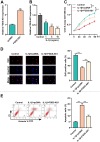FGD5-AS1 Inhibits Osteoarthritis Development by Modulating miR-302d-3p/TGFBR2 Axis
- PMID: 33834880
- PMCID: PMC8804797
- DOI: 10.1177/19476035211003324
FGD5-AS1 Inhibits Osteoarthritis Development by Modulating miR-302d-3p/TGFBR2 Axis
Abstract
Objective: Osteoarthritis (OA) is a common joint disorder, accompanied by extracellular matrix (ECM) degradation. Reportedly, long noncoding RNAs (lncRNAs) are involved in OA pathogenesis. However, the role of lncRNA FYVE, RhoGEF, and PH domain containing 5 antisense RNA 1 (FGD5-AS1) in OA development is still not fully clarified. This study was aimed to clarify the role of FGD5-AS1 in OA.
Methods: FGD5-AS1 and miR-302d-3p expression levels were determined in cartilage tissues and chondrocytes by quantitative real-time polymerase chain reaction (qRT-PCR). Chondrocytes (C20/A4 cells) were stimulated with interleukin 1β (IL-1β) to mimic the inflammatory environment of OA. Cell viability was detected by cell counting kit-8 and 5-ethynyl-2'-deoxyuridine assays. Cell apoptosis was measured by the caspase-3 activity assay and flow cytometry. Transforming growth factor beta receptors II (TGFBR2), matrix metalloproteinase 13 (MMP-13), and ADAM metallopeptidase with thrombospondin type 1 motif 5 expression levels were examined by qRT-PCR or Western blot. The regulatory relationships among FGD5-AS1, miR-302d-3p, and TGFBR2 were predicted by the StarBase v2.0, miRanda, miRDB, and TargetScan databases, and confirmed by dual-luciferase reporter assay and RNA immunoprecipitation assay.
Results: FGD5-AS1 and TGFBR2 expression levels were downregulated while miR-302d-3p expression was increased in cartilage tissues of OA patients. Knocking down FGD5-AS1 inhibited the viability of C20/A4 cells but induced apoptosis and ECM degradation, while FGD5-AS1 overexpression exerted opposite effects. MiR-302d-3p was identified as a target of FGD5-AS1, and TGFBR2 was identified as a target of miR-302d-3p. FGD5-AS1 positively regulated TGFBR2 expression by repressing miR-302d-3p expression, and miR-302d-3p inhibition or TGFBR2 restoration reversed the changes of cell viability, apoptosis, and ECM degradation induced by FGD5-AS1 knockdown.
Conclusion: FGD5-AS1 can probably inhibit OA progression by regulating miR-302d-3p/TGFBR2 axis.
Keywords: FGD5-AS1; MiR-302d-3p; TGFBR2; osteoarthritis.
Conflict of interest statement
Figures




Similar articles
-
LncRNA PART-1 targets TGFBR2/Smad3 to regulate cell viability and apoptosis of chondrocytes via acting as miR-590-3p sponge in osteoarthritis.J Cell Mol Med. 2019 Dec;23(12):8196-8205. doi: 10.1111/jcmm.14690. Epub 2019 Oct 1. J Cell Mol Med. 2019. PMID: 31571401 Free PMC article.
-
LncRNA MEG3 Inhibits the Degradation of the Extracellular Matrix of Chondrocytes in Osteoarthritis via Targeting miR-93/TGFBR2 Axis.Cartilage. 2021 Dec;13(2_suppl):1274S-1284S. doi: 10.1177/1947603519855759. Epub 2019 Jun 28. Cartilage. 2021. PMID: 31253047 Free PMC article.
-
CircSERPINE2 weakens IL-1β-caused apoptosis and extracellular matrix degradation of chondrocytes by regulating miR-495/TGFBR2 axis.Biosci Rep. 2020 Nov 27;40(11):BSR20201601. doi: 10.1042/BSR20201601. Biosci Rep. 2020. PMID: 33094798 Free PMC article.
-
Knockdown of lncRNA MFI2-AS1 inhibits lipopolysaccharide-induced osteoarthritis progression by miR-130a-3p/TCF4.Life Sci. 2020 Jan 1;240:117019. doi: 10.1016/j.lfs.2019.117019. Epub 2019 Oct 31. Life Sci. 2020. PMID: 31678554 Review.
-
LncRNA MALAT1 promotes osteoarthritis by modulating miR-150-5p/AKT3 axis.Cell Biosci. 2019 Jul 1;9:54. doi: 10.1186/s13578-019-0302-2. eCollection 2019. Cell Biosci. 2019. PMID: 31304004 Free PMC article. Review.
Cited by
-
The emerging role of lncRNAs in osteoarthritis development and potential therapy.Front Genet. 2023 Sep 14;14:1273933. doi: 10.3389/fgene.2023.1273933. eCollection 2023. Front Genet. 2023. PMID: 37779916 Free PMC article. Review.
-
LncRNAs as a new regulator of chronic musculoskeletal disorder.Cell Prolif. 2021 Oct;54(10):e13113. doi: 10.1111/cpr.13113. Epub 2021 Sep 8. Cell Prolif. 2021. PMID: 34498342 Free PMC article. Review.
-
miR-302d Targeting of CDKN1A Regulates DNA Damage and Steroid Hormone Secretion in Bovine Cumulus Cells.Genes (Basel). 2023 Dec 10;14(12):2195. doi: 10.3390/genes14122195. Genes (Basel). 2023. PMID: 38137018 Free PMC article.
-
FGD5-AS1 facilitates the osteogenic differentiation of human bone marrow-derived mesenchymal stem cells via targeting the miR-506-3p/BMP7 axis.J Orthop Surg Res. 2021 Nov 12;16(1):665. doi: 10.1186/s13018-021-02694-x. J Orthop Surg Res. 2021. PMID: 34772438 Free PMC article.
-
Genome-Wide Association Study of Potential Meat Quality Trait Loci in Ducks.Genes (Basel). 2022 May 31;13(6):986. doi: 10.3390/genes13060986. Genes (Basel). 2022. PMID: 35741748 Free PMC article.
References
MeSH terms
Substances
LinkOut - more resources
Full Text Sources
Other Literature Sources
Medical
Research Materials

